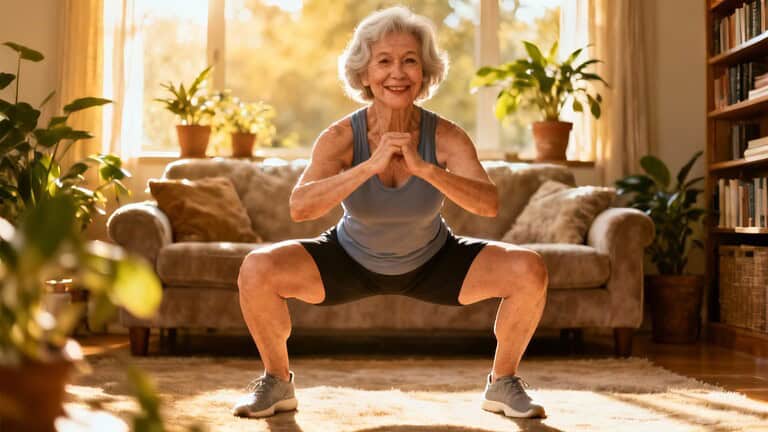Did you know that over 38% of Americans over 50 struggle with balance, joint pain, or weak lower body strength? This shocking statistic reveals a common problem that’s often preventable with the right approach to movement.
What if a single exercise from Japan could help you regain strength, stability, and confidence—all in just minutes a day?
The sumo squat, with its wide stance and deliberate movements, offers surprising benefits that go far beyond typical squats. This gentle yet powerful exercise has helped countless people over 50 rediscover their strength and independence.
Let’s explore the five remarkable benefits that make this simple movement a game-changer for senior wellness.
1. Wakes Up Sleeping Muscles That Aging Turns Off
As we age, our bodies naturally begin to turn off muscles we don’t regularly use—a process called sarcopenia that starts as early as our 30s.
The first muscles to go are typically the inner thighs, glutes, and deep hip stabilizers—the very muscles we need for standing, sitting, balancing, and even getting out of the car comfortably.
The sumo squat’s wide stance—feet wider than shoulder-width with toes slightly turned out—specifically targets these neglected areas.
Your adductors, inner thighs, and glute medius suddenly wake up after years of inactivity. These aren’t just vanity muscles; they’re anti-fall muscles that help distribute weight more evenly, reducing pressure on your knees and lower back.
2. Trains Your Body to Prevent Falls Before They Happen
Every 11 seconds, an older American visits the ER for a fall-related injury. The sumo squat addresses this critical issue by building proprioception—your body’s built-in GPS that tells your brain where your limbs are and whether you’re about to lose balance.
Unlike wobbly balance boards that can be risky, sumo squats provide grounded, controlled movement that safely challenges your internal balance system. This neuromuscular tune-up retrains the connection between your hips, knees, and ankles—the chain that determines whether you recover from a trip or fall.
Many people notice improvements within days, like no longer needing to grab walls when putting on socks.
3. Reignites Your Slowing Metabolism Naturally
One of the most frustrating aspects of aging is metabolic slowdown—eating and moving the same but watching the scale creep upward. The sumo squat offers a smart solution by activating your body’s largest calorie-burning muscles: the hips, thighs, and core.
The wide stance and deep angle engage these major muscle groups, creating a metabolic ripple effect that raises your baseline metabolism over time.
Unlike high-intensity workouts that spike and crash your heart rate, sumo squats provide a steady burn. Plus, the position naturally engages deep core muscles that support posture and help tighten your midsection from the inside out.
4. Supports Heart Health Without Stress
Heart health doesn’t always require breathless, high-intensity workouts. The sumo squat serves as a gentle circulatory booster that gets blood flowing efficiently without pushing your heart rate into dangerous zones.
When you perform sumo squats, your body recruits large muscle groups that require oxygen, prompting your heart to pump more efficiently. This low-impact approach helps maintain flexible arteries, healthy circulation, and stable blood pressure.
The slow, controlled breathing during the movement also activates your parasympathetic nervous system—reducing stress hormones, inflammation, and promoting better sleep.
5. Rebuilds Confidence and Independence
Perhaps the most overlooked benefit of the sumo squat is how it restores confidence. As we age, fear of falling or needing assistance can gradually shrink our world. The sumo squat serves as a powerful reminder that your body still belongs to you.
Each time you lower yourself slowly, hold steady, and rise back up using your own strength, you send a message to your brain: “I can still do this.” This micro-confidence builds with every repetition, translating to easier movement getting up from chairs, climbing stairs without gripping rails, and carrying groceries without wobbling.
How to Perform Sumo Squats Safely
Stand with feet wider than shoulder-width apart, toes turned slightly outward. Engage your core, keep your chest tall, and slowly lower your hips as if sitting onto an invisible low stool.
Stop when your thighs are parallel to the floor or as low as comfortable. Pause, then press through your heels to stand back up with control.
Start with five repetitions and gradually work up to 15. Use a chair behind you for support if needed. If you’ve had recent knee surgery, severe joint pain, hip replacements, or significant balance issues, consult your doctor or physical therapist before beginning.
Conclusion: Your Body’s Wake-Up Call
The sumo squat isn’t just another exercise—it’s a signal to your body that you’re still here, still capable, and still growing stronger. You don’t need expensive equipment or complicated routines to make a difference in your health and independence.
Sometimes, it just takes one smart movement practiced consistently to rebuild strength without punishment, confidence without ego, and health without overwhelm.
Whether you start with just five inches of movement today or work your way up gradually, the sumo squat offers a gentle path back to motion and independence.
This simple practice from Japan could be the key to unlocking stronger legs, better balance, and renewed confidence in your golden years.








